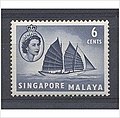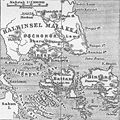Portal:Singapore
 Map of Singapore Singapore, officially the Republic of Singapore, is an island country and city-state in Southeast Asia. The country's territory comprises one main island, 63 satellite islands and islets, and one outlying islet. It is about one degree of latitude (137 kilometres or 85 miles) north of the equator, off the southern tip of the Malay Peninsula, bordering the Strait of Malacca to the west, the Singapore Strait to the south along with the Riau Islands in Indonesia, the South China Sea to the east, and the Straits of Johor along with the State of Johor in Malaysia to the north.
Singapore's history dates back at least eight hundred years, having been a maritime emporium known as Temasek and subsequently a major constituent part of several successive thalassocratic empires. Its contemporary era began in 1819, when Stamford Raffles established Singapore as an entrepôt trading post of the British Empire. In 1867, Singapore came under the direct control of Britain as part of the Straits Settlements. During World War II, Singapore was occupied by Japan in 1942 and returned to British control as a separate Crown colony following Japan's surrender in 1945. Singapore gained self-governance in 1959 and, in 1963, became part of the new federation of Malaysia, alongside Malaya, North Borneo, and Sarawak. Ideological differences led to Singapore's expulsion from the federation two years later; Singapore became an independent sovereign country in 1965. After early years of turbulence and despite lacking natural resources and a hinterland, the nation rapidly developed to become one of the Four Asian Tigers. As a highly developed country, it has one of the highest PPP-adjusted GDP per capita in the world. It is also identified as a tax haven. Singapore is the only country in Asia with a AAA sovereign credit rating from all major rating agencies. It is a major aviation, financial, and maritime shipping hub and has consistently been ranked as one of the most expensive cities to live in for expatriates and foreign workers. Singapore ranks highly in key social indicators: education, healthcare, quality of life, personal safety, infrastructure, and housing, with a home-ownership rate of 88 percent. Singaporeans enjoy one of the longest life expectancies, fastest Internet connection speeds, lowest infant mortality rates, and lowest levels of corruption in the world. It has the third highest population density of any country in the world, although there are numerous green and recreational spaces as a result of urban planning. With a multicultural population and in recognition of the cultural identities of the major ethnic groups within the nation, Singapore has four official languages: English, Malay, Mandarin, and Tamil. English is the common language, with exclusive use in numerous public services. Multi-racialism is enshrined in the constitution and continues to shape national policies in education, housing, and politics. Singapore is a parliamentary republic in the Westminster tradition of unicameral parliamentary government, and its legal system is based on common law. While the country is de jure a multi-party democracy with free elections, the government under the People's Action Party (PAP) wields widespread control and political dominance. The PAP has governed the country continuously since full internal self-government was achieved in 1959, and holds a supermajority in Parliament. One of the five founding members of ASEAN, Singapore is also the headquarters of the Asia-Pacific Economic Cooperation Secretariat, the Pacific Economic Cooperation Council Secretariat, and is the host city of many international conferences and events. Singapore is also a member of the United Nations, the World Trade Organization, the East Asia Summit, the Non-Aligned Movement, and the Commonwealth of Nations. (Full article...)Selected article -The history of the modern state of Singapore dates back to its founding in the early 19th century; however, evidence suggests that a significant trading settlement existed on the island in the 14th century. The last ruler of the Kingdom of Singapura, Parameswara, was expelled by the Majapahit or the Siamese before he founded Malacca. Singapore then came under the Malacca Sultanate and subsequently the Johor Sultanate. In 1819, British statesman Stamford Raffles negotiated a treaty whereby Johor would allow the British to locate a trading port on the island, ultimately leading to the establishment of the Crown colony of Singapore in 1867. Important reasons for the rise of Singapore were its nodal position at the tip of the Malay Peninsula flanked by the Pacific and Indian Oceans, the presence of a natural sheltered harbour, as well as its status as a free port. During World War II, Singapore was invaded and occupied by the Japanese Empire from 1942 to 1945. When the Japanese surrendered, Singapore reverted to British control, with increasing levels of self-government being granted, resulting in Singapore's merger with the Federation of Malaya to form Malaysia in 1963. However, social unrest, racial tensions, and political differences between Singapore's governing People's Action Party (PAP) and Malaysia's Alliance Party resulted in Singapore's expulsion from Malaysia. Singapore became an independent republic on 9 August 1965. By the 1990s, the country had established a highly developed free market economy and strong international trading links. It now has the highest per capita gross domestic product in Asia, which is 7th in the world, and it is ranked 9th on the UN Human Development Index. (Full article...) Selected picture The DHL Balloon is a giant helium balloon, located on Tan Quee Lan Street in the Downtown Core of Singapore. Sited next to the New 7th Storey Hotel and near Bugis MRT Station, the distinctive red and yellow commercial passenger balloon is the world's largest tethered helium balloon. Read more... General imagesThe following are images from various Singapore-related articles on Wikipedia.
Selected biography -Lee Choon Seng (Chinese: 李俊承; pinyin: Lǐ Jùnchéng; Pe̍h-ōe-jī: Lí Tsùn-sîng; 1888—5 June 1966) was a businessman and philanthropist in pre-independence Singapore. He founded several companies, cultivated rubber plantations in Malaya and started Chinese banks in the region. Lee held leadership roles in several Chinese community organisations in Singapore, notably the Singapore Chinese Chamber of Commerce and Industry (SCCCI), and supported Sun Yat-Sen's revolutionary cause in China. In addition, he promoted the growth of Buddhism in Singapore by setting up several Buddhist institutions, including the Singapore Buddhist Lodge, Singapore Buddhist Federation and Poh Ern Shih Temple. In 2008, his life and contributions to society were commemorated in a memorial hall at the Ee Hoe Hean Club. (Full article...) Did you know (auto-generated)
In this month
More did you know -
Selected panoramaThe National University of Singapore (Abbreviation: NUS; Chinese: 新加坡国立大学; pinyin: Xīnjiāpō Guólì Dàxué; Abbreviated 国大; Malay: Universiti Kebangsaan Singapura; Tamil: சிங்கப்பூர் தேசியப் பல்கலைக்கழகம் ) is Singapore's oldest university. It is the largest university in the country in terms of student enrollment and curriculum offered. Singapore topicsRelated portalsSoutheast Asia Other Countries Tasks
CategoriesWikiprojectsAssociated WikimediaThe following Wikimedia Foundation sister projects provide more on this subject:
Discover Wikipedia using portals |






























































